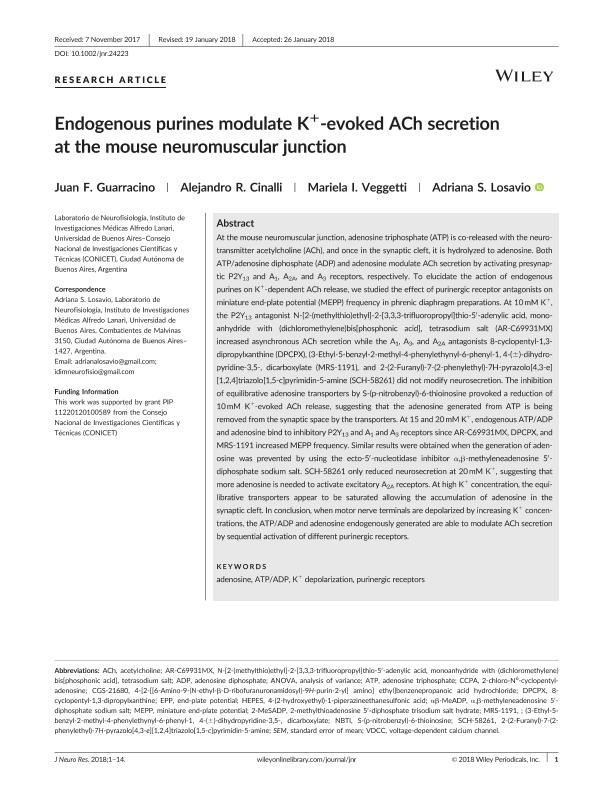Mostrar el registro sencillo del ítem
dc.contributor.author
Guarracino, Juan Francisco

dc.contributor.author
Cinalli, Alejandro Raúl

dc.contributor.author
Veggetti, Mariela Iris

dc.contributor.author
Losavio, Adriana Silvia

dc.date.available
2019-07-18T20:28:55Z
dc.date.issued
2018-06
dc.identifier.citation
Guarracino, Juan Francisco; Cinalli, Alejandro Raúl; Veggetti, Mariela Iris; Losavio, Adriana Silvia; Endogenous purines modulate K+-evoked ACh secretion at the mouse neuromuscular junction; Wiley-liss, Div John Wiley & Sons Inc; Journal of Neuroscience Research; 96; 6; 6-2018; 1066-1079
dc.identifier.issn
0360-4012
dc.identifier.uri
http://hdl.handle.net/11336/79852
dc.description.abstract
At the mouse neuromuscular junction, adenosine triphosphate (ATP) is co-released with the neurotransmitter acetylcholine (ACh), and once in the synaptic cleft, it is hydrolyzed to adenosine. Both ATP/adenosine diphosphate (ADP) and adenosine modulate ACh secretion by activating presynaptic P2Y13 and A1, A2A, and A3 receptors, respectively. To elucidate the action of endogenous purines on K+-dependent ACh release, we studied the effect of purinergic receptor antagonists on miniature end-plate potential (MEPP) frequency in phrenic diaphragm preparations. At 10 mM K+, the P2Y13 antagonist N-[2-(methylthio)ethyl]-2-[3,3,3-trifluoropropyl]thio-5′-adenylic acid, monoanhydride with (dichloromethylene)bis[phosphonic acid], tetrasodium salt (AR-C69931MX) increased asynchronous ACh secretion while the A1, A3, and A2A antagonists 8-cyclopentyl-1,3-dipropylxanthine (DPCPX), (3-Ethyl-5-benzyl-2-methyl-4-phenylethynyl-6-phenyl-1, 4-(±)-dihydropyridine-3,5-, dicarboxylate (MRS-1191), and 2-(2-Furanyl)-7-(2-phenylethyl)-7H-pyrazolo[4,3-e][1,2,4]triazolo[1,5-c]pyrimidin-5-amine (SCH-58261) did not modify neurosecretion. The inhibition of equilibrative adenosine transporters by S-(p-nitrobenzyl)-6-thioinosine provoked a reduction of 10 mM K+-evoked ACh release, suggesting that the adenosine generated from ATP is being removed from the synaptic space by the transporters. At 15 and 20 mM K+, endogenous ATP/ADP and adenosine bind to inhibitory P2Y13 and A1 and A3 receptors since AR-C69931MX, DPCPX, and MRS-1191 increased MEPP frequency. Similar results were obtained when the generation of adenosine was prevented by using the ecto-5′-nucleotidase inhibitor α,β-methyleneadenosine 5′-diphosphate sodium salt. SCH-58261 only reduced neurosecretion at 20 mM K+, suggesting that more adenosine is needed to activate excitatory A2A receptors. At high K+ concentration, the equilibrative transporters appear to be saturated allowing the accumulation of adenosine in the synaptic cleft. In conclusion, when motor nerve terminals are depolarized by increasing K+ concentrations, the ATP/ADP and adenosine endogenously generated are able to modulate ACh secretion by sequential activation of different purinergic receptors.
dc.format
application/pdf
dc.language.iso
eng
dc.publisher
Wiley-liss, Div John Wiley & Sons Inc

dc.rights
info:eu-repo/semantics/openAccess
dc.rights.uri
https://creativecommons.org/licenses/by-nc-sa/2.5/ar/
dc.subject
Adenosine
dc.subject
Atp/Adp
dc.subject
K+ Depolarization
dc.subject
Purinergic Receptors
dc.subject.classification
Neurociencias

dc.subject.classification
Medicina Básica

dc.subject.classification
CIENCIAS MÉDICAS Y DE LA SALUD

dc.title
Endogenous purines modulate K+-evoked ACh secretion at the mouse neuromuscular junction
dc.type
info:eu-repo/semantics/article
dc.type
info:ar-repo/semantics/artículo
dc.type
info:eu-repo/semantics/publishedVersion
dc.date.updated
2019-07-17T13:13:41Z
dc.journal.volume
96
dc.journal.number
6
dc.journal.pagination
1066-1079
dc.journal.pais
Estados Unidos

dc.journal.ciudad
Nueva York
dc.description.fil
Fil: Guarracino, Juan Francisco. Consejo Nacional de Investigaciones Científicas y Técnicas; Argentina. Universidad de Buenos Aires. Facultad de Medicina. Instituto de Investigaciones Médicas; Argentina
dc.description.fil
Fil: Cinalli, Alejandro Raúl. Universidad de Buenos Aires. Facultad de Medicina. Instituto de Investigaciones Médicas; Argentina. Consejo Nacional de Investigaciones Científicas y Técnicas. Instituto de Investigaciones en Ingeniería Genética y Biología Molecular "Dr. Héctor N. Torres"; Argentina
dc.description.fil
Fil: Veggetti, Mariela Iris. Consejo Nacional de Investigaciones Científicas y Técnicas; Argentina. Universidad de Buenos Aires. Facultad de Medicina. Instituto de Investigaciones Médicas; Argentina
dc.description.fil
Fil: Losavio, Adriana Silvia. Consejo Nacional de Investigaciones Científicas y Técnicas; Argentina. Universidad de Buenos Aires. Facultad de Medicina. Instituto de Investigaciones Médicas; Argentina
dc.journal.title
Journal of Neuroscience Research

dc.relation.alternativeid
info:eu-repo/semantics/altIdentifier/doi/http://dx.doi.org/10.1002/jnr.24223
dc.relation.alternativeid
info:eu-repo/semantics/altIdentifier/url/https://www.ncbi.nlm.nih.gov/pubmed/29436006
dc.relation.alternativeid
info:eu-repo/semantics/altIdentifier/url/https://onlinelibrary.wiley.com/doi/abs/10.1002/jnr.24223
Archivos asociados
